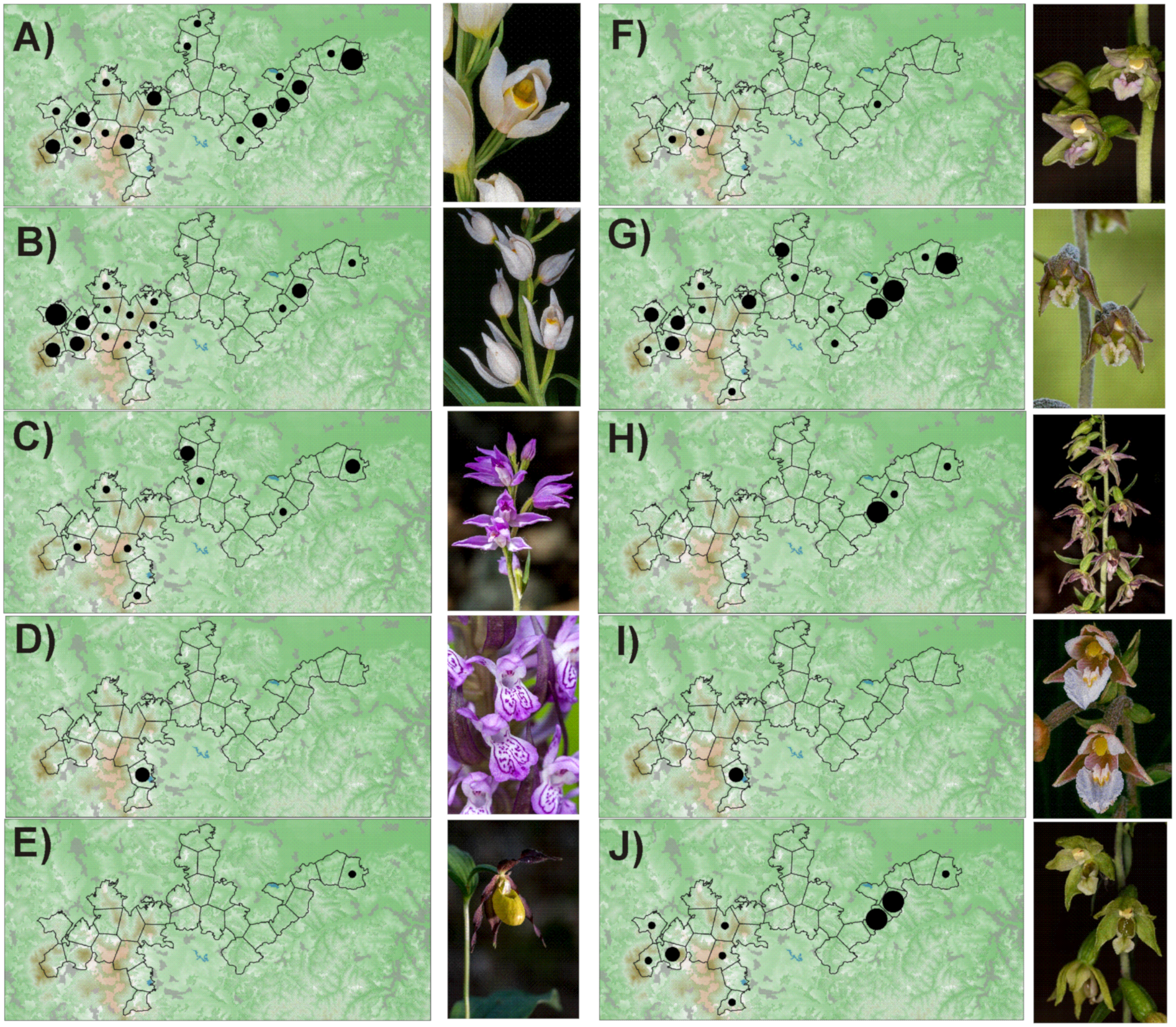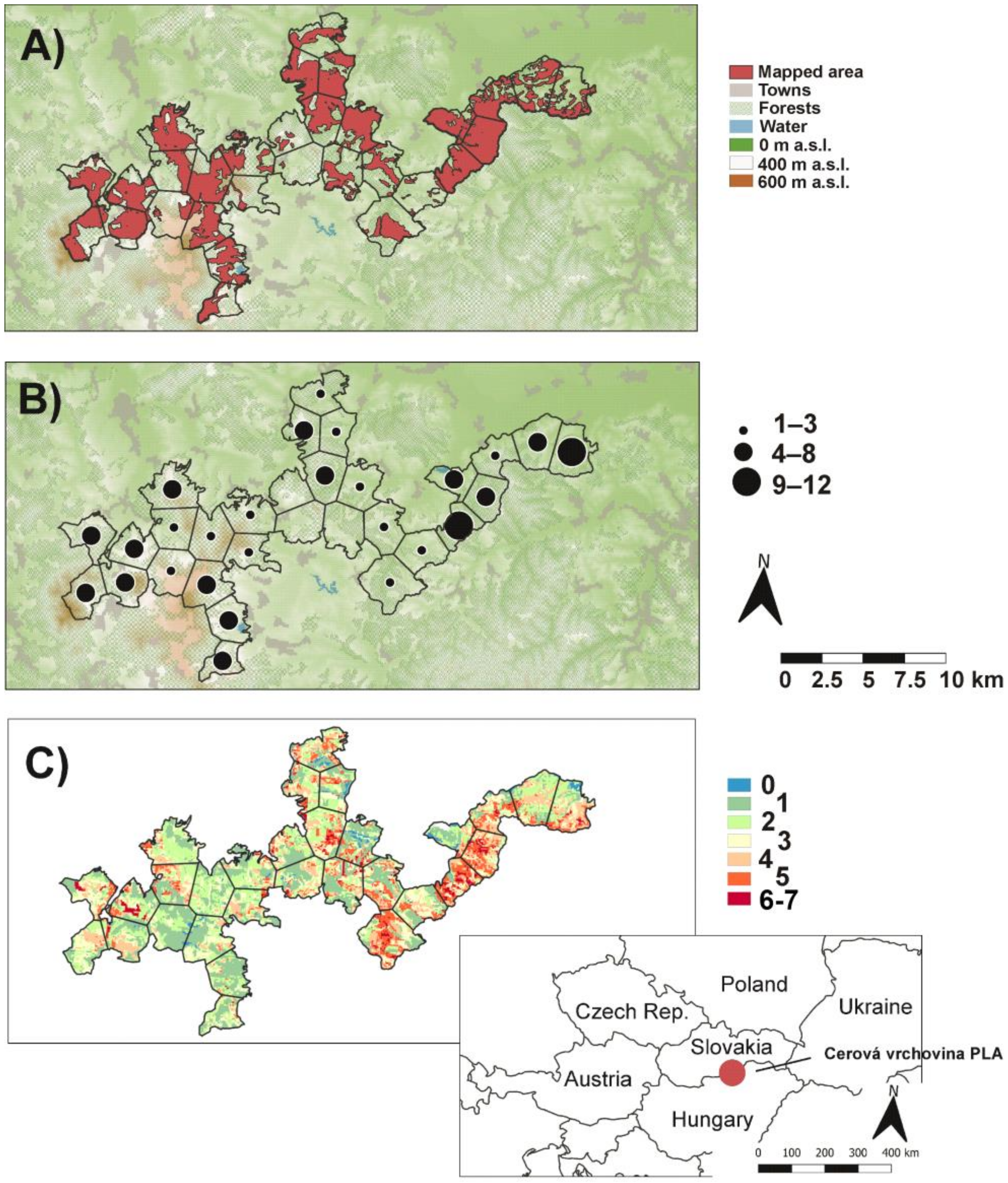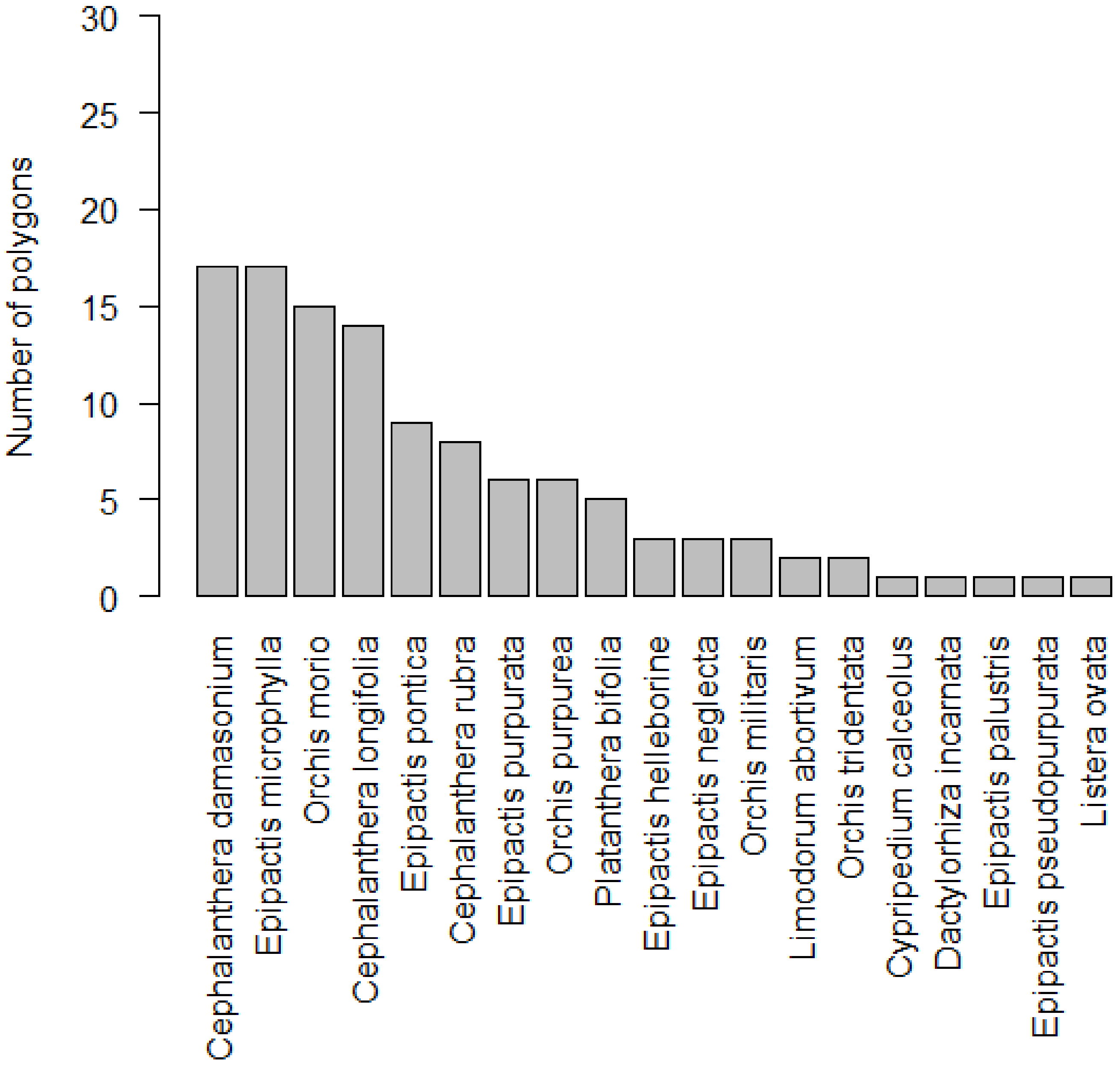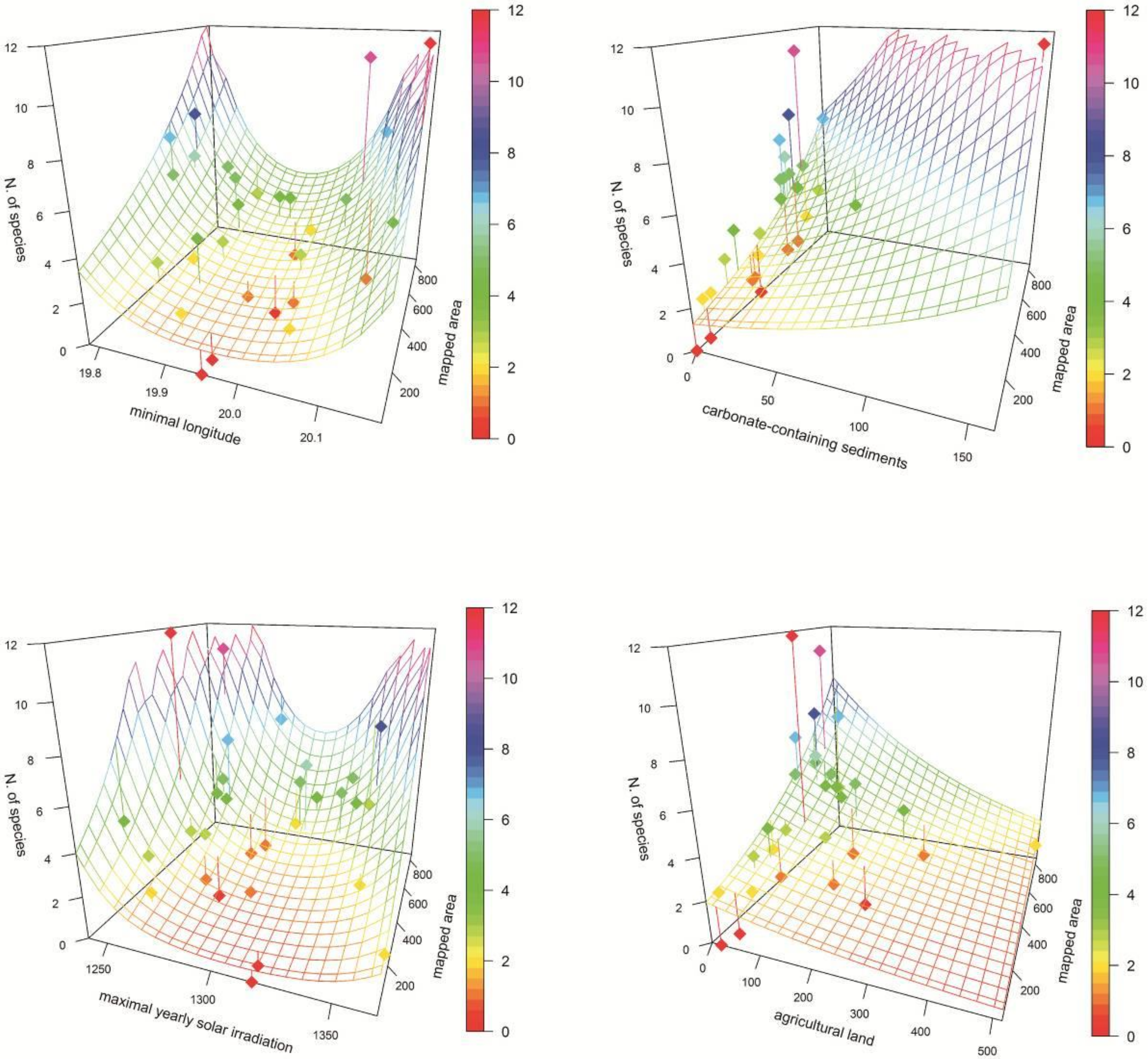Species Richness, Ecology, and Prediction of Orchids in Central Europe: Local-Scale Study
Abstract
1. Introduction
2. Materials and Methods
2.1. Study Area
2.2. Data Sampling and Analyses
3. Results
4. Discussion
4.1. Diversity of Orchids in a Central European Context
4.2. Effects of Ecological Factors on Orchids Diversity
4.3. Prediction of Orchid Occurrence and Nature Conservation Consequences
5. Conclusions
Supplementary Materials
Author Contributions
Funding
Acknowledgments
Conflicts of Interest
Appendix A


References
- Dressler, R.L. The Orchids: Natural History and Classification; Harvard University Press: Cambridge, MA, USA, 1981; pp. 1–332. [Google Scholar]
- Swarts, N.D.; Dixon, K.W. Terrestrial orchid conservation in the age of extinction. Ann. Bot. 2009, 104, 543–556. [Google Scholar] [CrossRef]
- Chase, M.; Christenhusz, M.; Mirenda, T. The Book of Orchids: A Life-Size Guide to Six Hundred Species from around the World; Ivy Press: London, UK, 2017; pp. 1–656. [Google Scholar]
- Delforge, P. Orchids of Europe, North Africa and the Middle East; A & C Black: London, UK, 2006; pp. 1–640. [Google Scholar]
- Comes, H.P.; Kadereit, J.W. The effect of Quaternary climatic changes on plant distribution and evolution. Trends Plant Sci. 1998, 3, 432–438. [Google Scholar] [CrossRef]
- Médail, F.; Diadema, K. Glacial refugia influence plant diversity patterns in the Mediterranean Basin. J. Biogeogr. 2009, 36, 1333–1345. [Google Scholar] [CrossRef]
- Wraith, J.; Pickering, C. Quantifying anthropogenic threats to orchids using the IUCN Red List. Ambio 2018, 47, 307–317. [Google Scholar] [CrossRef]
- Aceto, S.; Caputo, P.; Cozzolina, S.; Gaudio, L.; Moretti, A. Phylogeny and Evolution of Orchis and Allied Genera Based on ITS DNA Variation: Morphological Gaps and Molecular Continuity. Mol. Phylog. Evol. 1999, 13, 67–76. [Google Scholar] [CrossRef] [PubMed]
- Devos, N.; Tyteca, D.; Raspé, O.; Wesselingh, R.A.; Jaquemart, A.-L. Patterns of chloroplast diversity among western European Dactylorhiza species (Orchidaceae). Plant Syst. Evol. 2003, 243, 85–97. [Google Scholar] [CrossRef]
- Bayman, P.; González, E.J.; Fumero, J.J.; Tremblay, R.L. Are fungi necessary? How fungicides affect growth and survival of the orchid Lepanthes rupestris in the field. J. Ecol. 2002, 90, 1002–1008. [Google Scholar] [CrossRef]
- Rasmussen, H.N. Recent developments in the study of orchid mycorrhiza. Plant Soil 2002, 244, 149–163. [Google Scholar] [CrossRef]
- Yam, T.W.; Arditti, J. History of orchid propagation: A mirror of the history of biotechnology. Plant Biotechnol. Rep. 2009, 3, 1. [Google Scholar] [CrossRef]
- Wraith, J.; Norman, P.; Pickering, K. Orchid conservation and research: An analysis of gaps and priorities for globally Red Listed species. Ambio 2020. [Google Scholar] [CrossRef]
- Sonkoly, J.; Vojtkó, A.E.; Tökölyi, J.; Török, P.; Sramkó, G.; Illyés, Z.; Molnár, V.A. Higher seed number compensates for lower fruit set in deceptive orchids. J. Ecol. 2016, 104, 343–351. [Google Scholar] [CrossRef]
- Fantinato, E.; Del Vecchio, S.; Baltieri, M.; Fabris, B.; Buffa, G. Are food-deceptive orchid species really functionally specialized for pollinators? Ecol. Res. 2017, 32, 951–959. [Google Scholar] [CrossRef]
- Štípková, Z.; Tsiftsis, S.; Kindlmann, P. Pollination mechanisms are driving orchid distribution in space. Sci. Rep. 2020, 10, 850. [Google Scholar] [CrossRef]
- Djordjević, V.; Tsiftsis, S. The role of ecological factors in distribution and abundance of terrestrial orchids. In Orchids Phytochemistry, Biology and Horticulture; Reference Series in Phytochemistry; Mérillion, J.-M., Kodja, H., Eds.; Springer International Publishing: Basel, Switzerland, 2020; pp. 1–71. [Google Scholar] [CrossRef]
- Djordjević, V.; Tsiftsis, S. Patterns of orchid species richness and composition in relation to geological substrates. Wulfenia 2019, 26, 1–21. [Google Scholar]
- Dijk, E.; Willems, J.H.; van Andel, J. Nutrient responses as a key factor to the ecology of orchid species. Acta Bot. Neerl. 1997, 46, 339–363. [Google Scholar] [CrossRef]
- Janečková, P.; Wotavová, K.; Schödelbaureová, I.; Jersáková, J.; Kindlmann, P. Relative effects of management and environmental conditions on performance and survival of populations of a terrestrial orchids. Biol. Conserv. 2006, 129, 40–49. [Google Scholar] [CrossRef]
- Tsiftsis, S.; Tsiripidis, I.; Karagiannakidou, V.; Alifragis, D. Niche analysis and conservation of the orchids of east Macedonia (NE Greece). Acta Oecol. 2018, 33, 27–35. [Google Scholar] [CrossRef]
- Hrivnák, R.; Gömöry, D.; Cvachová, A. Inter-annual variability of the abundance and morphology of Dactylorhiza majalis (Orchidaceae-Orchideae) in two permanent plots of a mire in Slovakia. Phyton Horn 2006, 46, 27–44. [Google Scholar]
- Slaviero, A.; Del Vecchio, S.; Pierce, S.; Fantinato, E.; Buffa, G. Plant community attributes affect dry grassland orchid establishment. Plant Ecol. 2016, 217, 1533–1543. [Google Scholar] [CrossRef]
- Tsiftsis, S.; Štípková, Z.; Kindlmann, P. Role of way of life, latitude, elevation and climate on the richness and distribution of orchid species. Biodiv. Conserv. 2019, 28, 75–96. [Google Scholar] [CrossRef]
- Procházka, A.; Mikita, T.; Jelínek, P. The relationship between some forest stand properties and the occurrence of orchids in the central parts of the Moravian Karst Protected Landscape Area. Acta Univ. Silvic. Mendel. Brun. 2017, 65, 919–931. [Google Scholar] [CrossRef]
- Štípková, Z.; Ramportl, D.; Černocká, V.; Kindlmann, P. Factors associated with the distributions of orchids in the Jeseníky Mountains, Czech Republic. Eur. J. Environ. Sci. 2017, 7, 135–145. [Google Scholar] [CrossRef]
- Elith, J.; Graham, C.H.; Anderson, R.P.; Dudík, M.; Ferrier, S.; Guisan, A.; Hijmans, R.J.; Huettmann, F.; Leathwick, J.R.; Lehmann, A.; et al. Novel methods improve prediction of species’ distributions from occurrence data. Ecography 2006, 29, 129–151. [Google Scholar] [CrossRef]
- Lapin, M.; Faško, P.; Melo, M.; Štastný, P.; Tomlain, J. Climatic districts. Map No. 27. In Landscape Atlas of the Slovak Republici, 1st ed.; Miklóš, L., Ed.; Ministry of Environment Slovak Republic: Bratislava, Slovakia, 2002; p. 95. [Google Scholar]
- Kiss, G. (Ed.) A Karancs-Medves és a Csered-hegység Tájvédelmi Körzet. Nógrád és Gömör határán; Bükki Nemzeti Park Igazgatóság: Eger, Hungary, 2007; pp. 1–382. [Google Scholar]
- GeoModel Solar. GIS Data and Maps for Europe, Turkey and North Africa. Technical Report No. 121-01/2014; Šúri, M., Ed.; GeoModel Solar: Bratislava, Slovakia, 2014; pp. 1–58. [Google Scholar]
- Vlčko, J.; Dítě, D.; Kolník, M. Vstavačovité Slovenska; ZO SZOPK Orchidea: Zvolen, Slovakia, 2003; pp. 1–120. [Google Scholar]
- Eliáš, P.; Dítě, D.; Kliment, J.; Hrivnák, R.; Feráková, V. Red list of ferns and flowering plants of Slovakia, 5th edition (October 2014). Biologia 2015, 70, 218–228. [Google Scholar] [CrossRef]
- Niklfeld, H. Bericht über die Kartierung der Flora Mitteleuropas. Taxon 1971, 20, 545–571. [Google Scholar] [CrossRef]
- Austin, M.P.; Cunningham, R.B.; Fleming, P.N. New approaches to direct gradient analysis using environmental scalars and statistical curve-fitting procedures. Vegetatio 1984, 55, 11–27. [Google Scholar] [CrossRef]
- QGIS Development Team. QGIS Geographic Information System; Open Source Geospatial Foundation Project. 2020. Available online: qgis.osgeo.org (accessed on 6 February 2020).
- R Core Team. R: A Language and Environment for Statistical Computing; R Foundation for Statistical Computing: Vienna, Austria, 2018; Available online: www.R-project.org (accessed on 6 February 2020).
- Steven, J.P.; Dudík, M.; Schapire, R.E. Maxent Software for Modeling Species Niches and Distributions (Version 3.4.1). 2020. Available online: http://biodiversityinformatics.amnh.org/open_source/maxent/ (accessed on 6 February 2020).
- Marhold, K.; Hindák, F. (Eds.) Checklist of Non-Vascular and Vascular Plants of Slovakia; Veda: Bratislava, Slovakia, 1998; pp. 1–687. [Google Scholar]
- Molnár, V.A. Magyarország Orchideáinak Atlasza; Kossuth Kiadó: Budapest, Hungary, 2011; pp. 1–510. [Google Scholar]
- Hrivnák, R.; Hrivnák, M.; Slezák, M.; Vlčko, J.; Baltiarová, J.; Svitok, M. Distribution and eco-coenotic patterns of the forest orchid Epipactis pontica in Slovakia. Ann. For. Res. 2014, 57, 55–69. [Google Scholar] [CrossRef]
- Potůček, O. Kľúč na Určovanie Vstavačovitých Československa; Rosalia, Mimoriadne Vydanie: Nitra, Slovakia, 1990; pp. 1–154. [Google Scholar]
- Jatiová, M.; Šmiták, J. Rozšíření a Ochrana Orchidejí na Moravě a ve Slezku; ArcaJiMfa: Třebíč, Czech Republic, 1996; pp. 1–545. [Google Scholar]
- Hrivnák, R.; Palkovič, J. Orchis Tridentata Scop. v Cerovej vrchovine. Bull. Slov. Bot. Spoločn. 1996, 18, 106–107. [Google Scholar]
- Slezák, M.; Hrivnák, R.; Belanová, E.; Jarčuška, B. Komentovaný prehľad zaujímavých nálezov cievnatých rastlín z územia stredného Slovenska. Bull. Slov. Bot. Spoločn. 2010, 32, 59–71. [Google Scholar]
- Štípková, Z.; Kosánová, K.; Romportl, D.; Kindlmann, P. Determinants of Orchid Occurrence: A Czech Example, Selected Studies in Biodiversity; IntechOpen: London, UK, 2018. [Google Scholar]
- Elith, J.; Phillips, S.J.; Hastie, T.; Dudík, M.; Chee, Y.E.; Yates, C.J. A statistical explanation of MaxEnt for ecologists. Divers. Distrib. 2011, 17, 43–57. [Google Scholar] [CrossRef]
- Naczk, A.M.; Kolanowska, M. Glacial Refugia and Future Habitat Coverage of Selected Dactylorhiza Representatives (Orchidaceae). PLoS ONE 2015, 10, e0143478. [Google Scholar] [CrossRef] [PubMed]
- Martinis, A.; Chaideftou, E.; Minotou, C.; Poirazidis, K. Spatial analysis of orchids diversity unveils hot-spots: The case of Zante Island, Greece. J. Agricult. Inform. 2018, 9, 26–40. [Google Scholar] [CrossRef]
- Vass, D. (Ed.) Geológia Lučenskej kotliny a Cerovej vrchoviny; Štátny geologický ústav Dioníza Štúra: Bratislava, Slovakia, 2007; pp. 1–284. [Google Scholar]



| Variable | Abbreviation | Model | Pseudo-r2 | P | Multiple Testing |
|---|---|---|---|---|---|
| 1 Minimal longitude | x_min | Polynomial | 0.3906 | 0.0016 | * |
| 2 Geology bedrock: carbonate-containing sediments | gVap | Linear | 0.2605 | 0.0047 | * |
| 3 Maximal yearly solar irradiation | r13_max | Polynomial | 0.3354 | 0.0049 | * |
| 4 Corine landscape type: Agricultural land | cAgr | Linear | 0.1450 | 0.0416 | ns |
| 1 Median xericity | xericita_median | Linear | 0.0966 | 0.1008 | ns |
| 1 Longitude range | x_range | Linear | 0.0897 | 0.1144 | ns |
| 4 Number of Corine landscape types | Ncorine | Linear | 0.0821 | 0.1318 | ns |
| 3 Maximal yearly solar irradiation | r13_range | Polynomial | 0.1390 | 0.1429 | ns |
| 3 Median yearly solar irradiation | r13_median | Linear | 0.0604 | 0.1986 | ns |
| 4 Corine landscape type: Forests | cFor | Linear | 0.0586 | 0.2058 | ns |
| 1 Minimal xericity | xericita_min | Linear | 0.0528 | 0.2306 | ns |
| 1 Median latitude | y_median | Linear | 0.0474 | 0.2567 | ns |
| 2 Geology bedrock: Quaternary sediments | gKvar | Linear | 0.0467 | 0.2601 | ns |
| 3 Minimal yearly solar irradiation | r13_min | Linear | 0.0285 | 0.3810 | ns |
| 1 Xericity Range | xericita_range | Linear | 0.0226 | 0.4359 | ns |
| 2 Geology bedrock: Tertiary sediments | gSed | Linear | 0.0155 | 0.5203 | ns |
| 2 Geology inverse Simpson index | iSgeoCl | Linear | 0.0149 | 0.5278 | ns |
| 1 Minimal elevation | dem_min | Linear | 0.0145 | 0.5343 | ns |
| 2 Number of geology bedrock types | nGeo | Linear | 0.0117 | 0.5772 | ns |
| 4 Corine landscape type inverse Simpson index | iScorineCl | Linear | 0.0054 | 0.7052 | ns |
| 2 Geology bedrock: Vulcanites | gVul | Linear | 0.0045 | 0.7295 | ns |
| 3 Range of temperature between warmest and the coldest month | bio7_range | Linear | 0.0011 | 0.8639 | ns |
| 4 Corine landscape type: Pastures | cPast | Linear | 0.0011 | 0.8673 | ns |
| 1 Maximal xericity | xericita_max | Linear | 0.0007 | 0.8927 | ns |
| 3 Range of yearly precipitation | p13_range | Linear | 0.0004 | 0.9211 | ns |
| 1 Range of latitude | y_range | Linear | 0.0000 | 0.9818 | ns |
| Percent Contribution/Permutation Importance | |||||||||
|---|---|---|---|---|---|---|---|---|---|
| Species | AUC | Threshold | Area | dem | r13 | bio7 | xericity | CLC | geo |
| C. damasonium | 0.862 | 0.198 | 0.420 | 0.4/0.0 | 0.1/0.1 | 25.3/46.3 | 15.9/18.8 | 31.2/22.0 | 27.0/12.8 |
| C. longifolia | 0.892 | 0.212 | 0.298 | 13.0/18.8 | 0.1/0.0 | 1.0/3.1 | 4.8/5.9 | 24.9/18.9 | 56.2/53.3 |
| C. rubra | 0.904 | 0.304 | 0.307 | 0.6/2.6 | 0.0/0.0 | 0.0/0.0 | 45.6/54.6 | 37.2/37.3 | 16.6/5.5 |
| E. microphylla | 0.878 | 0.194 | 0.356 | 2.6/0.0 | 1.1/3.9 | 24.7/42.4 | 26.2/16.1 | 27.5/33.7 | 17.9/3.9 |
| E. neglecta | 0.951 | 0.362 | 0.136 | 0.7/3.4 | 10.8/17.8 | 40.2/34.7 | 3.5/1.1 | 26.9/32.1 | 18.0/10.8 |
| E. pontica | 0.909 | 0.209 | 0.286 | 1.3/1.7 | 3.6/1.9 | 31.6/21.8 | 14.0/12.8 | 42.8/55.1 | 6.7/6.7 |
| E. purpurata | 0.873 | 0.334 | 0.404 | 0.0/0.0 | 0.0/0.0 | 0.0/0.0 | 9.3/12.3 | 52.1/53.6 | 38.6/34.2 |
| O. morio | 0.848 | 0.297 | 0.376 | 6.4/4.1 | 2.4/3.2 | 1.5/0.0 | 0.4/0.0 | 66.9/85.7 | 22.4/6.9 |
| O. purpurea | 0.946 | 0.201 | 0.110 | 13.9/69.8 | 0.4/2.3 | 6.1/2.3 | 3.8/3.2 | 15.7/1.9 | 60.0/20.6 |
| Average | 0.896 | 0.257 | 0.299 | 4.3/11.2 | 2.1/3.2 | 14.5/16.7 | 13.7/13.9 | 36.1/37.8 | 29.3/17.2 |
© 2020 by the authors. Licensee MDPI, Basel, Switzerland. This article is an open access article distributed under the terms and conditions of the Creative Commons Attribution (CC BY) license (http://creativecommons.org/licenses/by/4.0/).
Share and Cite
Hrivnák, M.; Slezák, M.; Galvánek, D.; Vlčko, J.; Belanová, E.; Rízová, V.; Senko, D.; Hrivnák, R. Species Richness, Ecology, and Prediction of Orchids in Central Europe: Local-Scale Study. Diversity 2020, 12, 154. https://doi.org/10.3390/d12040154
Hrivnák M, Slezák M, Galvánek D, Vlčko J, Belanová E, Rízová V, Senko D, Hrivnák R. Species Richness, Ecology, and Prediction of Orchids in Central Europe: Local-Scale Study. Diversity. 2020; 12(4):154. https://doi.org/10.3390/d12040154
Chicago/Turabian StyleHrivnák, Matúš, Michal Slezák, Dobromil Galvánek, Jaroslav Vlčko, Eva Belanová, Veronika Rízová, Dušan Senko, and Richard Hrivnák. 2020. "Species Richness, Ecology, and Prediction of Orchids in Central Europe: Local-Scale Study" Diversity 12, no. 4: 154. https://doi.org/10.3390/d12040154
APA StyleHrivnák, M., Slezák, M., Galvánek, D., Vlčko, J., Belanová, E., Rízová, V., Senko, D., & Hrivnák, R. (2020). Species Richness, Ecology, and Prediction of Orchids in Central Europe: Local-Scale Study. Diversity, 12(4), 154. https://doi.org/10.3390/d12040154






